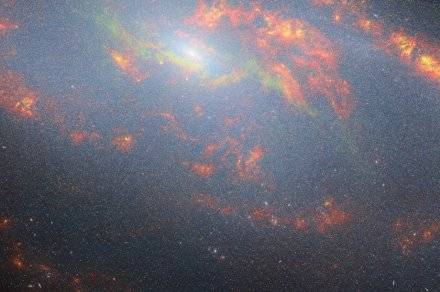Exploring the Cosmic Splendor of Messier 106: A Gateway to the James Galaxy
In the vast expanse of our universe, galaxies come in a mesmerizing array of shapes and sizes, each offering a unique glimpse into the workings of cosmic evolution. Among these stellar islands is Messier 106, a grand spiral galaxy that commands attention not only for its striking appearance, but also for its intriguing features and the mysteries it holds. This article delves into the wonders of Messier 106, often referred to as M106, and explores its place in the cosmos, including its recent association with the term “James Galaxy.”
Messier 106: A Celestial Overview
Messier 106 is located in the constellation Canes Venation, about 21 million light-years away from Earth. It was discovered by the French astronomer Pierre Méchain in 1781 and subsequently included in the Messier catalog by his colleague, the famous comet hunter, Charles Messier. This catalog is a list of astronomical objects compiled in the late 18th century that remains a cornerstone for amateur and professional astronomers alike.
M106 is classified as a spiral galaxy, which means it has a distinct, rotating disk with spiral arms that wind outward from the center. It is a member of the M106 group of galaxies, which also includes the galaxies NGC 4248 and NGC 4217. The galaxy is notable for its large size and luminous appearance, with a diameter of approximately 80,000 light-years, making it slightly larger than our own Milky Way galaxy.
Distinctive Features and Unique Characteristics
What sets Messier 106 apart from many other spiral galaxies is its peculiar and intriguing features. One of the most fascinating aspects of M106 is the presence of an active galactic nucleus (AGN) at its center. This AGN is powered by a supermassive black hole, which is consuming surrounding matter and emitting high-energy radiation. This active nucleus contributes to M106’s classification as a Seyfert galaxy, a type of galaxy with an exceptionally bright and energetic core.
In addition to its AGN, Messier 106 exhibits a phenomenon known as “anomalous arms.” These are unusually extended spiral arms that are brightened by regions of intense star formation and interstellar dust. The galaxy also shows signs of a significant amount of hydrogen gas and molecular clouds in its spiral arms, contributing to ongoing star formation.
Another interesting feature of M106 is its extended halo of hot, X-ray-emitting gas. This halo provides clues about the galaxy’s past interactions with other galaxies and the nature of its dark matter halo.
Recent Observations and Discoveries
Recent observations using advanced telescopes, including the Hubble Space Telescope and various radio telescopes, have provided new insights into Messier 106. One of the most notable recent discoveries is the detailed mapping of its hydrogen gas distribution, which has revealed complex structures in the galaxy’s outer regions. This mapping helps astronomers understand the dynamics of star formation and the interaction between different components of the galaxy.
Moreover, studies of M106’s AGN have shed light on the behavior of its central black hole. Observations in various wavelengths, from radio to X-rays, have allowed scientists to analyze the accretion disk and the relativistic jets being ejected from the black hole. These observations help researchers understand the mechanisms driving AGS and their impact on the galaxy’s evolution.
The James Galaxy Connection
In recent discussions among astronomers and popular science media, there has been some confusion or miscommunication regarding the term “James Galaxy” in relation to Messier 106. The term “James Galaxy” is not an official astronomical designation but rather a colloquial or speculative reference to the galaxy in some contexts. It is essential to distinguish between such informal terms and the established nomenclature used in scientific literature.
The confusion may stem from the association of James Webb Space Telescope (JWST) with galaxy observations. The JWST, named after James E. Webb, has provided unprecedented images and data on numerous galaxies, including Messier 106. Its advanced instruments offer detailed views of distant galaxies, enhancing our understanding of their structure and evolution. However, there is no formal classification of Messier 106 as the “James Galaxy.”
Conclusion
Messier 106 remains a subject of fascination and study for astronomers and space enthusiasts alike. Its distinctive features, from the active galactic nucleus to the extended spiral arms, make it a compelling object of observation. As our observational technology advances, particularly with the contributions of telescopes like the James Webb Space Telescope, our understanding of M106 and similar galaxies will continue to deepen.
In the grand tapestry of the cosmos, Messier 106 stands as a vivid reminder of the beauty and complexity of the universe. Its study not only provides insights into the nature of spiral galaxies but also offers a window into the broader processes shaping galaxies across cosmic time. As we continue to explore and learn, M106 will undoubtedly remain a stellar example of the wonders awaiting discovery in the vastness of space. Distinctive features and unique characteristics









